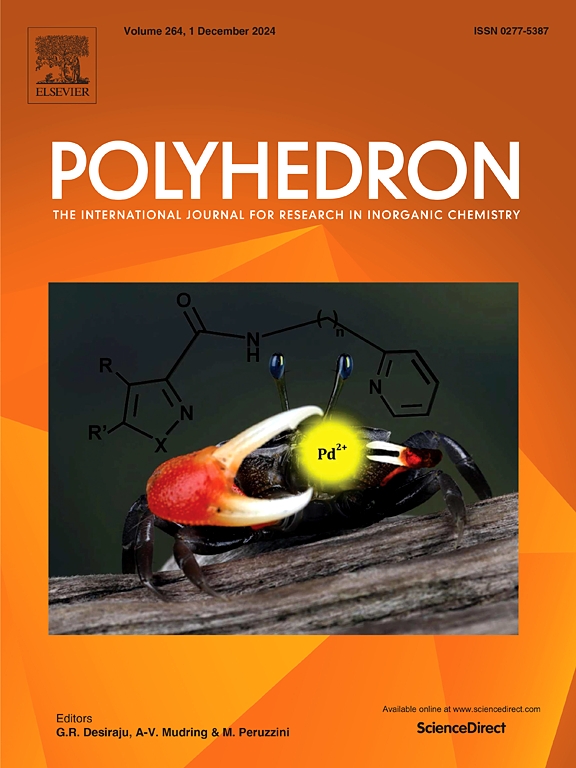On the nature of the boron-sulfur multiple bonds from the quantum chemical topology perspective – The theoretical investigation using electron localisation function (ELF)
IF 2.4
3区 化学
Q2 CHEMISTRY, INORGANIC & NUCLEAR
引用次数: 0
Abstract
The electron localization function (ELF) is a powerful quantum chemical tool for analysing bonding in molecules. This study applies ELF topological analysis to boron-sulfur (BS) bonds, distinguishing between single, double, and formally triple bonds. The results reveal that BS bonds exhibit strong polarity due to sulfur’s high electron-withdrawing capability. ELF analysis demonstrates that the concept of a triple BS bond is not supported, as the electron populations in bonding basins do not reach expected values for true triple bonds. Instead, these interactions are better described as resonance hybrids with covalent and dative contributions.
This study investigates 16 molecules containing BS bonds, selected to cover a range of bonding scenarios. The analysis of V(B,S) basin populations and BS bond lengths confirms distinct bonding characteristics. Formally single BS bonds exhibit the longest bond lengths (up to 1.922 Å) and the lowest basin populations (∼1.69e). Formally double bonds present intermediate bond lengths (1.799–1.850 Å) and basin populations around 1.97–1.98e. Molecules proposed to contain triple BS bonds display significantly lower basin populations (3.14–3.23e) than expected for true triple bonds, challenging their classification.
These findings refine our understanding of multiple bonding in boron chemistry and provide insights into electronic structure and reactivity. ELF analysis proves essential for characterizing bonding interactions beyond traditional valence models. The results have implications for designing BS-containing materials, particularly in catalysis and advanced applications. Further studies should examine external factors such as pressure, temperature, and substituent effects on BS bonding.

从量子化学拓扑的角度看硼硫多键的性质——利用电子定域函数(ELF)的理论研究
电子定位函数(ELF)是分析分子成键的一种强大的量子化学工具。本研究将ELF拓扑分析应用于硼硫(BS)键,区分单键、双键和正式的三键。结果表明,由于硫的高吸电子能力,BS键具有很强的极性。ELF分析表明,三重BS键的概念不被支持,因为成键盆地中的电子居群没有达到真正三键的期望值。相反,这些相互作用被更好地描述为具有共价和加法贡献的共振杂化。本研究调查了16个含有BS键的分子,选择了一系列的键合场景。V(B,S)盆地种群和BS键长分析证实了明显的键合特征。形式上,单个BS键具有最长的键长(高达1.922 Å)和最低的盆地种群(~ 1.69e)。正式的双键呈现中间键长(1.799-1.850 Å)和流域种群约1.97-1.98e。含有三重BS键的分子显示出明显低于真实三键的盆地种群(3.14-3.23e),这对它们的分类提出了挑战。这些发现完善了我们对硼化学中多键的理解,并提供了对电子结构和反应性的见解。ELF分析证明了在传统价模型之外表征键相互作用的必要条件。研究结果对设计含bs材料,特别是在催化和高级应用方面具有重要意义。进一步的研究应该考察外部因素,如压力、温度和取代基对BS键合的影响。
本文章由计算机程序翻译,如有差异,请以英文原文为准。
求助全文
约1分钟内获得全文
求助全文
来源期刊

Polyhedron
化学-晶体学
CiteScore
4.90
自引率
7.70%
发文量
515
审稿时长
2 months
期刊介绍:
Polyhedron publishes original, fundamental, experimental and theoretical work of the highest quality in all the major areas of inorganic chemistry. This includes synthetic chemistry, coordination chemistry, organometallic chemistry, bioinorganic chemistry, and solid-state and materials chemistry.
Papers should be significant pieces of work, and all new compounds must be appropriately characterized. The inclusion of single-crystal X-ray structural data is strongly encouraged, but papers reporting only the X-ray structure determination of a single compound will usually not be considered. Papers on solid-state or materials chemistry will be expected to have a significant molecular chemistry component (such as the synthesis and characterization of the molecular precursors and/or a systematic study of the use of different precursors or reaction conditions) or demonstrate a cutting-edge application (for example inorganic materials for energy applications). Papers dealing only with stability constants are not considered.
 求助内容:
求助内容: 应助结果提醒方式:
应助结果提醒方式:


